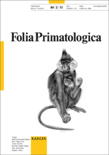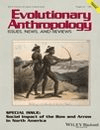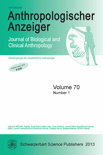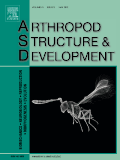
HOMO-JOURNAL OF COMPARATIVE HUMAN BIOLOGY
Scope & Guideline
Fostering Innovation in Comparative Studies
Introduction
Aims and Scopes
- Human Morphology and Anatomy:
The journal publishes studies that investigate human skeletal features, dental characteristics, and overall anatomy, often utilizing advanced imaging techniques and statistical methods. - Comparative Analysis of Populations:
Research often involves comparative studies across different populations, examining variations in biological traits and their implications for understanding human evolution and adaptation. - Interdisciplinary Approaches:
The journal encourages the integration of methodologies from various fields, including bioarchaeology, anthropology, and biostatistics, to enrich the understanding of human biology. - Health and Disease Patterns:
Papers frequently explore the relationship between biological traits and health outcomes, including studies on disability, chronic conditions, and their historical contexts. - Evolutionary Perspectives:
The journal emphasizes the evolutionary aspects of human biology, including studies that link contemporary findings to prehistoric human populations and their lifestyles.
Trending and Emerging
- Health and Longevity Research:
Recent studies have increasingly focused on the relationship between biological factors and health outcomes, particularly in aging populations, highlighting the importance of understanding longevity in various contexts. - 3D Imaging and Morphometrics:
The use of advanced 3D imaging techniques and geometric morphometrics is on the rise, allowing for more precise and detailed analyses of skeletal structures and their variations across populations. - Impact of Diet on Biological Traits:
Research examining the links between dietary practices and physiological traits, such as dental wear and fat distribution, is gaining traction, underscoring the role of nutrition in human biology. - Integrative Studies of Mobility and Subsistence Patterns:
There is a growing interest in understanding how mobility and subsistence strategies impact human health and skeletal development, particularly in archaeological contexts. - Prenatal and Early Life Influences on Health:
Emerging studies are focusing on the effects of prenatal stress and early life conditions on long-term health outcomes, emphasizing the importance of early interventions in public health.
Declining or Waning
- Traditional Osteology:
There has been a noticeable decrease in traditional osteological studies that focus solely on skeletal remains without integrating broader biological or environmental contexts. - Static Morphometric Studies:
Research that primarily employs static measurements of skeletal features without considering dynamic or functional aspects has become less common, as newer methods emphasize more holistic approaches. - Historical Bioarchaeology:
While still relevant, the focus on purely historical bioarchaeological studies is waning, possibly due to a shift towards contemporary applications and interdisciplinary research that includes modern population studies. - Single-Factor Analyses:
Studies that analyze human biology based on a single variable or factor are becoming less frequent, as researchers increasingly recognize the complexity of biological traits and their interactions.
Similar Journals

ANTHROPOLOGICAL SCIENCE
Pioneering research that shapes the future of anthropology.ANTHROPOLOGICAL SCIENCE is a prominent journal in the field of anthropology, published by the Anthropological Society of Nippon since 1993. With a rich pedigree of scholarly contributions, this journal is an essential platform for disseminating research findings and theoretical discussions that push the boundaries of anthropological knowledge. Currently ranked in the Q3 category in Anthropology by 2023 metrics, ANTHROPOLOGICAL SCIENCE boasts an impressive position at #163 out of 502 in Scopus, placing it in the 67th percentile among its peers. While it operates under a traditional access model, the journal supports a diverse range of anthropological research encompassing cultural, biological, and archaeological perspectives. Researchers, professionals, and students will find valuable insights and innovative methodologies that foster a richer understanding of human societies and behaviors. The current trends and findings published in this journal make it a crucial resource for those involved in anthropological studies or related fields.

JOURNAL OF EVOLUTIONARY BIOCHEMISTRY AND PHYSIOLOGY
Advancing Knowledge at the Intersection of Biochemistry and PhysiologyJOURNAL OF EVOLUTIONARY BIOCHEMISTRY AND PHYSIOLOGY, published by PLEIADES PUBLISHING INC, is a pivotal periodical that delves into the intricate relationships between biochemical processes and evolutionary dynamics. With its ISSN 0022-0930 and E-ISSN 1608-3202, this journal serves as a comprehensive platform for researchers, professionals, and students dedicated to understanding the physiological adaptations and biochemical mechanisms influenced by evolutionary pressures. Although it is not an open access journal, it offers valuable insights across its historically significant coverage spanning from 1972 to 2017, making it an essential resource for those working in agricultural, biological, and molecular sciences. Despite its current Scopus rankings revealing limited visibility within its fields, the journal remains committed to fostering scholarly dialogue and advancing knowledge in the realm of evolutionary biochemistry, especially for those exploring the ecological, genetic, and integrative physiological aspects of life.

Anthropologie-International Journal of Human Diversity and Evolution
Advancing Knowledge in Evolutionary AnthropologyAnthropologie-International Journal of Human Diversity and Evolution is a prominent peer-reviewed journal published by the esteemed MORAVIAN MUSEUM in the heart of the Czech Republic. With a focus on anthropology, this journal serves as a vital platform for the dissemination of innovative research that explores human diversity and evolutionary studies. The journal operates under a rigorous academic framework and is categorized in the Q3 quartile for anthropology in 2023, reflecting its significance in the field. Although it does not currently offer open access options, Anthropologie facilitates the exchange of knowledge through its carefully curated articles spanning diverse topics within human evolution. Its Scopus ranking (320 out of 502 in social sciences) underscores its role as a relevant source for scholars and professionals alike, fostering dialogue and advancements in understanding human diversity. Researchers, students, and practitioners can look forward to engaging content that not only enlightens but also inspires further inquiry into anthropological studies.

Journal of Language Evolution
Illuminating the Path of Linguistic TransformationThe Journal of Language Evolution, published by Oxford University Press, serves as a vital resource in the intersection of linguistics, psychology, and neuroscience. With an ISSN of 2058-4571, this prestigious journal has established itself as a prominent platform for innovative research since its inception in 2016, converging valuable insights up to 2023. It boasts notable rankings, including Q1 in Linguistics and Language and Q2 in both Developmental and Educational Psychology and Developmental Neuroscience, reflecting its high impact and relevance in the academic community. The journal is indexed in Scopus, where it ranks in the 93rd percentile for Linguistics and Language, showcasing its influence among leading scholars. Researchers, professionals, and students will find the journal’s rigorous analysis and interdisciplinary approach essential for advancing their understanding of language evolution and its broader implications. Although access is limited, the journal’s commitment to excellence positions it as a must-read for those engaged in these dynamic fields.

FOLIA PRIMATOLOGICA
Fostering Understanding of Primates in a Global ContextFOLIA PRIMATOLOGICA is a prestigious academic journal published by BRILL, focusing on the interdisciplinary fields of animal science and zoology, as well as ecology and evolutionary biology. With an ISSN of 0015-5713 and E-ISSN 1421-9980, the journal has been a significant contributor to the understanding of primatology since its inception in 1963 and continues to disseminate impactful research through 2024. The journal is recognized in the Q2 quartile for Animal Science and Zoology and Q3 for Ecology, Evolution, Behavior, and Systematics, showcasing a solid reputation within the academic community. Both Scopus rankings and percentiles indicate its influence, with a rank of 137/490 in Animal Science and 277/721 in Ecology and Evolution, reflecting its relevance and commitment to promoting high-quality research. Though it does not operate on an open-access model, FOLIA PRIMATOLOGICA remains a vital resource for researchers, professionals, and students alike, striving to advance the understanding of primates and their ecological contexts within a global framework.

EVOLUTION AND HUMAN BEHAVIOR
Innovating Understanding of Behavior in an Evolutionary ContextEVOLUTION AND HUMAN BEHAVIOR, published by Elsevier Science Inc, is a leading interdisciplinary journal that explores the intricate relationships between evolutionary processes, human behavior, and cognition. With an impressive impact factor reflecting its rigorous peer-reviewed content and high citation rates, this journal falls in the prestigious Q1 quartile across multiple categories including Arts and Humanities, Ecology, Evolution, Behavior and Systematics, and Experimental and Cognitive Psychology, solidifying its critical role in advancing research in these fields. Since its inception in 1997 and moving towards 2024, it has consistently provided a platform for innovative research and insights, attracting contributions from a diverse range of disciplines. The journal is accessible through various open access options, ensuring that groundbreaking research is widely disseminated for maximum impact. Researchers, professionals, and students alike benefit from the cutting-edge studies published within, making EVOLUTION AND HUMAN BEHAVIOR an essential resource for those looking to deepen their understanding of the evolutionary context of human actions and interactions.

EVOLUTIONARY ANTHROPOLOGY
Illuminating the Path of Human Development Through ResearchEVOLUTIONARY ANTHROPOLOGY is a premier journal published by WILEY, dedicated to advancing the field of anthropology through innovative and rigorous research. With an ISSN of 1060-1538 and an E-ISSN of 1520-6505, this journal boasts a remarkable Q1 ranking in both the Anthropology and Medicine (miscellaneous) categories, reflecting its significant impact within the academic community. Since its inception in 1992, it has continuously evolved, now encompassing a wide array of subjects pertinent to evolutionary studies and human health. Residing in the highly competitive Scopus rankings, it stands at an impressive rank of 10 out of 502 in the field, placing it within the top 2% of journals in Social Sciences - Anthropology. Researchers, professionals, and students alike will find this journal an invaluable resource for the latest findings, theoretical advancements, and discussions that shape our understanding of human evolution and its biological implications. While not categorized as an Open Access journal, EVOLUTIONARY ANTHROPOLOGY remains a vital outlet for high-quality scholarship, fostering dialogue and enriching knowledge across diverse audiences.

ANTHROPOLOGISCHER ANZEIGER
Innovating Research at the Confluence of SpeciesANTHROPOLOGISCHER ANZEIGER, published by E Schweizerbart'sche Verlagsbuchhandlung, is a distinguished journal dedicated to the interdisciplinary fields of anthropology, animal science, and ecology, with a notable impact on advancing research in these areas. Since its inception in 1971, the journal has played a critical role in providing a platform for innovative research, fostering scholarly exchange, and enhancing the understanding of human and animal interactions and ecosystems. With its current quartile rankings—Q2 in Anthropology and Q3 in Animal Science and Zoology—it is well-positioned to serve as a vital resource for researchers, professionals, and students alike. Although it does not currently offer open access, the journal remains an essential asset for those looking to deepen their knowledge and contribute to ongoing discussions within these intersecting disciplines. For additional information, visit the publisher's office located at NAEGELE U OBERMILLER, SCIENCE PUBLISHERS, JOHANNESSTRASSE 3A, D 70176 STUTTGART, GERMANY.

ARTHROPOD STRUCTURE & DEVELOPMENT
Illuminating the Evolution of ArthropodsARTHROPOD STRUCTURE & DEVELOPMENT, published by Elsevier Science Ltd, is a leading journal dedicated to the intricate study of arthropod morphology, physiology, and developmental biology. With an ISSN of 1467-8039 and an E-ISSN of 1873-5495, this journal plays a critical role in advancing our understanding of insect science as demonstrated by its impressive Q1 ranking in this category. It occupies a respected position within the academic landscape, being ranked Q3 in Developmental Biology and Q2 in both Ecology, Evolution, Behavior and Systematics, and Medicine (miscellaneous), illustrating its interdisciplinary appeal. Covering research from 2000 to 2024, ARTHROPOD STRUCTURE & DEVELOPMENT offers a robust platform for researchers who are keen to unlock the complexities of arthropod life, contributing significantly to the fields of entomology and ecological research. Open access options ensure that groundbreaking discoveries are readily available to a global audience, fostering collaboration and innovation. As a vital resource for students, professionals, and academics, this journal is indispensable for those dedicated to exploring the fascinating world of arthropods.

GENETICS AND MOLECULAR BIOLOGY
Transforming research into impactful discoveries.GENETICS AND MOLECULAR BIOLOGY, published by the SOC BRASIL GENETICA, is a prominent journal dedicated to the advancement of knowledge in the fields of genetics and molecular biology. Since its inception in 1998, this Open Access journal has served as a vital platform for researchers, professionals, and students to disseminate their findings and engage with the latest innovations and discoveries. With an impact factor that reflects its growing influence, GENETICS AND MOLECULAR BIOLOGY ranks in the Q3 category for both genetics and molecular biology as of 2023, indicating its position within the academic community. The journal is indexed in Scopus, highlighting its commitment to maintaining rigorous peer-review standards while providing wide-reaching access to quality research. Operating out of Ribeirão Preto, Brazil, it fosters a collaborative environment for academic discourse and research development not only in Brazil but also globally. The journal encourages submissions that explore a wide range of topics in genetics and molecular biology, making it an essential resource for anyone involved in these dynamic fields.